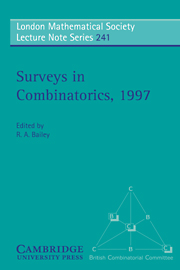Book contents
- Frontmatter
- Contents
- Preface
- M13
- The Harmonious Chromatic Number and the Achromatic Number
- Computer Construction of Block Designs
- Finite Quasiprimitive Graphs
- Tree Width and Tangles: A New Connectivity Measure and Some Applications
- Minor-monotone Graph Invariants
- Some Applications of Algebraic Curves in Finite Geometry and Combinatorics
- New Perspectives on Interval Orders and Interval Graphs
- Approximate Counting
- Author Index
- Subject Index
New Perspectives on Interval Orders and Interval Graphs
Published online by Cambridge University Press: 29 March 2010
- Frontmatter
- Contents
- Preface
- M13
- The Harmonious Chromatic Number and the Achromatic Number
- Computer Construction of Block Designs
- Finite Quasiprimitive Graphs
- Tree Width and Tangles: A New Connectivity Measure and Some Applications
- Minor-monotone Graph Invariants
- Some Applications of Algebraic Curves in Finite Geometry and Combinatorics
- New Perspectives on Interval Orders and Interval Graphs
- Approximate Counting
- Author Index
- Subject Index
Summary
Summary Interval orders and interval graphs are particularly natural examples of two widely studied classes of discrete structures: partially ordered sets and undirected graphs. So it is not surprising that researchers in such diverse fields as mathematics, computer science, engineering and the social sciences have investigated structural, algorithmic, enumerative, combinatorial, extremal and even experimental problems associated with them. In this article, we survey recent work on interval orders and interval graphs, including research on on-line coloring, dimension estimates, fractional parameters, balancing pairs, hamiltonian paths, ramsey theory, extremal problems and tolerance orders. We provide an outline of the arguments for many of these results, especially those which seem to have a wide range of potential applications. Also, we provide short proofs of some of the more classical results on interval orders and interval graphs. Our goal is to provide fresh insights into the current status of research in this area while suggesting new perspectives and directions for the future.
Introduction
A complex process (manufacturing computer chips, for example) is often broken into a series of tasks, each with a specified starting and ending time. Task A precedes Task B if A ends before B begins. When A precedes B, the output of A can safely be used as input to B, and resources dedicated to the completion of A, such as machines or personnel, can now be applied to B. When A and B have overlapping time periods, they may be viewed as conflicting tasks, in the sense that they compete for limited resources.
- Type
- Chapter
- Information
- Surveys in Combinatorics, 1997 , pp. 237 - 286Publisher: Cambridge University PressPrint publication year: 1997
- 8
- Cited by



